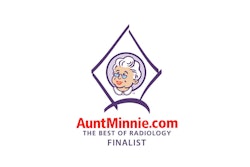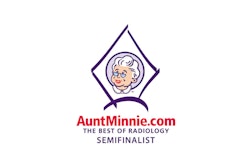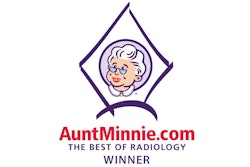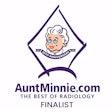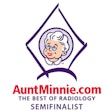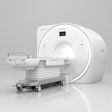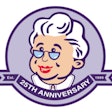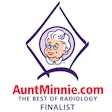The Minnies Expert Panel has spoken. After two competitive rounds of voting on over 100 nominees in 15 categories, the winners have been selected for the 2025 edition of the Minnies, our annual awards program recognizing excellence in radiology.
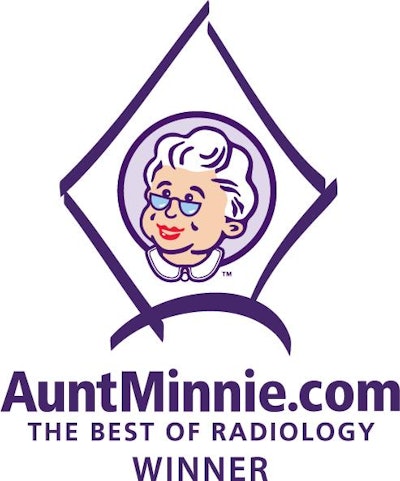
This year, issues impacting the radiology workforce and theranostics feature prominently. Minnies 2025 recipients include a few previous trophy winners, as well as several first-timers. We’ve also once again invited winners to say a few words about their award, and we hope you enjoy our article as well as the opportunity to hear directly from the recipients.
Congratulations to all the winners of the 2025 Minnies awards, and also to the runners-up and the hundreds of candidates who made the semifinalist list and finalist list.
Interested in the history of the Minnies? You can view our comprehensive list of all the Minnies winners over the past 25 years.
Most Influential Radiology Researcher
Minnies 2025 Winner: Eric Christensen, PhD, Harvey L. Neiman Health Policy Institute
Eric Christensen, PhD, sees the world through an economist's eyes.
"I approach problems within the framework of the question of what we would expect a population to do in response to the economics of the situation," he said. "How does it play out? The fact is, economic incentives influence people whether they're aware of them or not."
 Eric Christensen, PhD.
Eric Christensen, PhD.
Christensen has been with the Harvey L. Neiman Health Policy Institute (HPI) since 2021, and although he has specialized in healthcare economics throughout his career, the focus on radiology is new. His work experience has included conducting interdisciplinary research at the Center for Naval Analyses' Institute for Public Research in Arlington, VA; serving on the Health Services Management faculty at the University of Minnesota College of Continuing & Professional Studies in Minneapolis; and conducting health economic research at Children's Hospitals and Clinics of Minnesota, also in Minneapolis (to name just a few).
"Radiology has its own unique issues," he said. "For example, many healthcare models assume a face-to-face doctor/patient relationship, but this is not necessarily the case for radiology. Because not all physicians are the same, the approach should reflect that."
He and his colleagues regularly interview experts about trends in radiology and follow legislative changes. In the past few years, his team has published studies about Black women's access to new mammography technology, rates of nonradiologists' interpretation of office-based imaging, potential causes of a future radiology workforce shortage, the financial effects of the No Surprises Act, and how imaging studies interpreted by nonphysician practitioners are often repeated. Currently, he's working on research regarding workforce concerns such as attrition and turnover, Medicare reimbursement and its association with healthcare disparities, and procedural complexity for interventional radiologists.
"In the future, we'd like to do more to explore the value of radiology in terms of its impact on patient care -- particularly as it relates to radiologists' role in reducing low-value imaging -- and of course to track what's coming next in the field so we can inform health policy discussions," he said.
Runner-up: Florence Doo, MD, University of Maryland School of Medicine
Most Effective Radiology Educator
Minnies 2025 Winner: Lea Alhilali, MD, Arizona State Shufeldt School of Medicine and Medical Engineering
First-time Minnies winner Lea Alhilali, MD, pivoted to education after years of engaging in "traditional academics" at Harvard Medical School, UT Southwestern Medical Center, Barrow, and the University of Pittsburgh.
 Lea Alhilali, MD.
Lea Alhilali, MD.
Part of her shift was prompted by her term as program director of Barrow's neuroradiology fellowship, during which she learned via feedback from her students to use social media for teaching. Her efforts in this regard have taken off: On X and Instagram, she has 67,000 and 105,000 followers, respectively.
"I assumed social media was for posting cute pictures of my kids for my friends," she said. "Initially, it didn't occur to me that social media could be a way to teach. But the new generation of doctors I teach use social media as a matter of course, so I posted some of my lectures and found that they got some good notice."
At Arizona State, Alhilali is part of the team working to establish a radiology department at the new medical school there. She is also in charge of the school's medical student rotation program. In addition to her teaching duties, Alhilali is active in the academic journal arena, serving as senior editor for education for the American Journal of Neurology, associate editor of social media and digital innovation for Radiographics, and deputy editor for Clinical Neuroimaging. As well, the open-access radiology resource Radiopaedia.org hosts a page with links to her lectures.
Alhilali finds being an educator deeply satisfying. She has lectured around the world to audiences that include medical students, residents, attendings, vendors, and representatives from imaging firms; recently, she donated more than 100 of her recorded talks to Mount Kilimanjaro Medical Center in Tanzania, a facility that does not have a full-time neuroradiologist available.
"There's an incredible demand for radiology education that is understandable and can be communicated in fresh ways," she said. "As radiologists, we can use social media to put out reliable, accurate content."
Runner-up: Matthew Hartman, MD, Allegheny Health Network
Most Effective Radiologic Sciences Educator
Minnies 2025 Winner: Jennifer Thompson, Austin Peay State University, Clarksville, TN
Jennifer Thompson's move from New Mexico to Austin Peay State University in Clarksville, TN, opened the door that led to her 2025 Minnies win for Most Effective Radiologic Sciences Educator. It's a role she takes to heart.
 Jennifer Thompson.
Jennifer Thompson.
As a professor and radiologic science program director at Austin Peay, Thompson creates educational and advocacy opportunities for students through her tutoring, advising, research, speaking engagements, capital visits, recruitment, and volunteering with the Tennessee Society of Radiologic Technologists (TSRT), which includes the annual meeting for which she plays a key role in the meeting's development.
Professional development is a requirement for Thompson's students through the American Society of Radiologic Technologists, including attending the annual meeting.
"I am invited for speaking engagements around the country, and I invite my students to speak with me because I have to give them the ability to learn how to advocate for themselves and to teach others," she said. "I use my platform to give them one."
Thompson also collaborates with other healthcare programs to create interprofessional simulations that stage patient journeys. These simulations offer students the opportunity to interact with and advocate for other professionals, including medical laboratory scientists, nurses, and others. Students discuss their roles as radiologic technologists and progression to other roles, such as radiologist assistant.
"This is so we can put together our scopes of practice and make it all make sense as they're in clinic," she said.
Thompson gamifies classroom lessons, too. For example, she has created a unique anatomical relationship matching game and has repurposed board games such as Candy Land to keep students highly engaged.
"Students are learning to think critically when we create our own rules rather than using the textbook," she said. "This is a crucial step in becoming an imaging professional."
Interest in Austin Peay's radiologic science program is flourishing, according to Thompson, who has facilitated expanding the curriculum with new affiliation agreements.
“I am truly humbled by this recognition and profoundly grateful to be acknowledged for contributing to the educational journey of our students at APSU, as well as to the broader professional community across the United States," Thompson said in an APSU blog post.
Thompson has been director of the Austin Peay State University Radiologic Sciences Program since 2018.
"It's taken a lot of determination to get me to this point," she said. "Myself, my kids pushing me, and love of the profession. As an educator, I miss my daily interactions with patients, but I would never be able to give back to the community as much as I can now."
Runner-up: Tobias Gilk, Gilk Radiology Consultants, Overland Park, KS
Most Effective Radiology Administrator/Manager
Minnies 2025 Winner: Ashley Darby, University of Mississippi Medical Center (UMMC) and Children's of Mississippi, Jackson, MS
University of Mississippi Medical Center (UMMC)'s Ashley Darby has been named AuntMinnie's Most Effective Radiology Administrator/Manager for 2025.
 Ashley Darby.
Ashley Darby.
“This recognition reflects the work of many, not one," Darby told AuntMinnie. "Success in healthcare is never an individual achievement -- it’s shared, supported, and strengthened by every voice at the table. Progress for us in imaging services at UMMC has been and will continue to be built on our people.”
Darby now serves as executive director of health system clinical operations for UMMC, the only academic medical system in the state of Mississippi. Her strong clinical background in diagnostic radiology, CT, general ultrasound, and vascular ultrasound serves her well in her new role.
On the horizon at UMMC is a modernized and centralized breast imaging department planned to relocate back to UMMC's main campus. The health system is leaning into cutting-edge theranostics and has also embarked on building a new teaching facility nearby in Ridgeland, MS, that will house UMMC's first ambulatory surgical center.
All of this is in addition to the system's 2025 acquisition of a nearby hospital, Merit Health Madison Hospital, located in Canton, approximately 20 miles away from UMMC's main Jackson, MS, metro campus.
“I am grateful to work in an environment where growing people is as essential as treating patients," Darby added. "When we invest in skill, talent, and human potential, we elevate care for every community we serve.”
Much of the advanced imaging in the state of Mississippi takes place at UMMC. However, the system maintains three community hospitals and outreach and collaborative care arrangements throughout the state.
Darby's management philosophy is based on values, skill growth, and transformation. "When our values guide our strategy, excellence becomes not a goal, but a culture," she said.
Nominated for a Minnies award in both 2023 and 2024, Darby is affiliated with the Mississippi Chapter of the American College of Healthcare Executives. She holds a master's degree in business administration, specializing in project management, and a master's degree in health administration, both obtained from Louisiana State University Shreveport.
Runner-up: Terri Franklin, University of Alabama Birmingham (UAB) Hospital and UAB Highlands, Birmingham, AL




